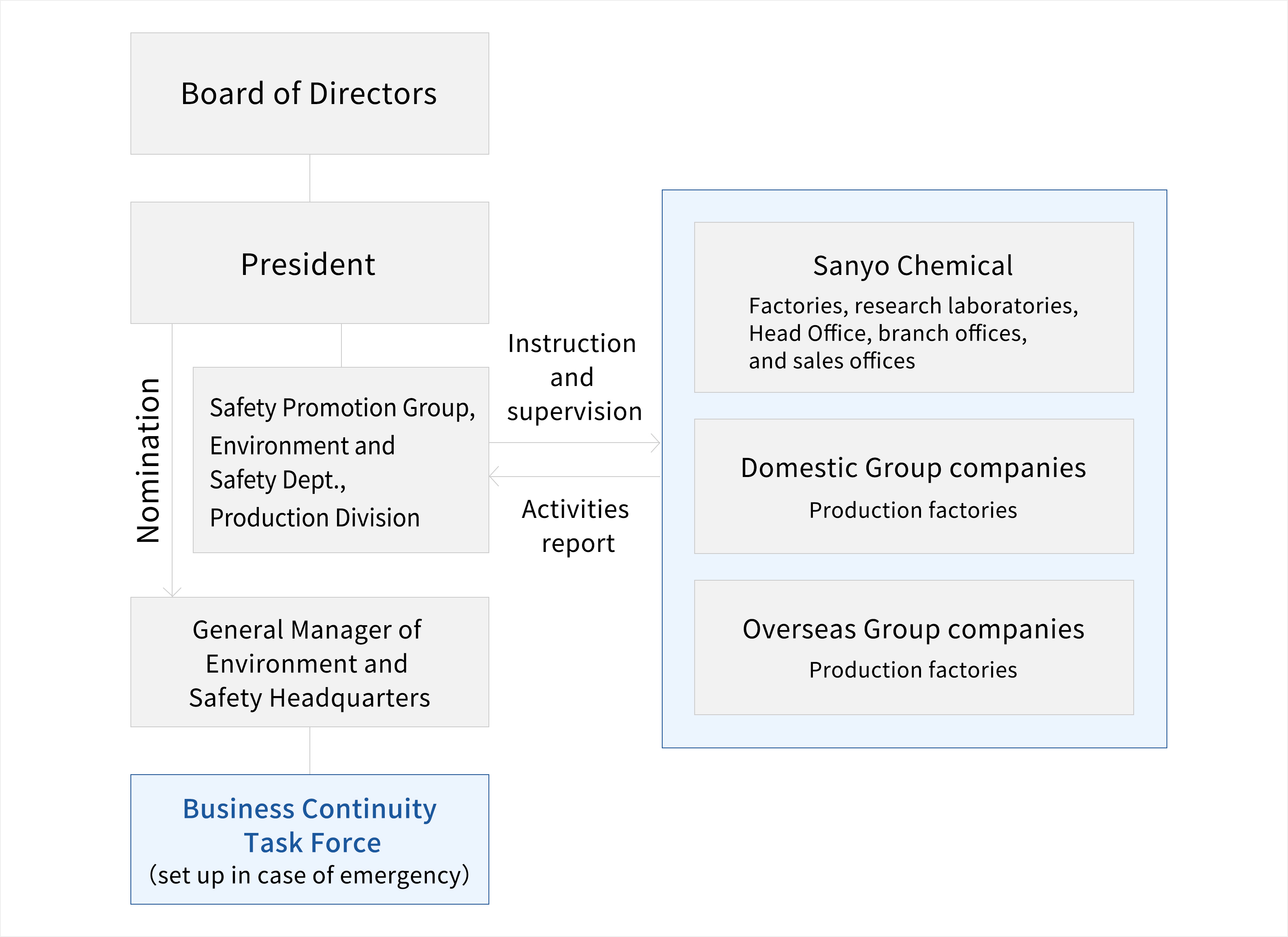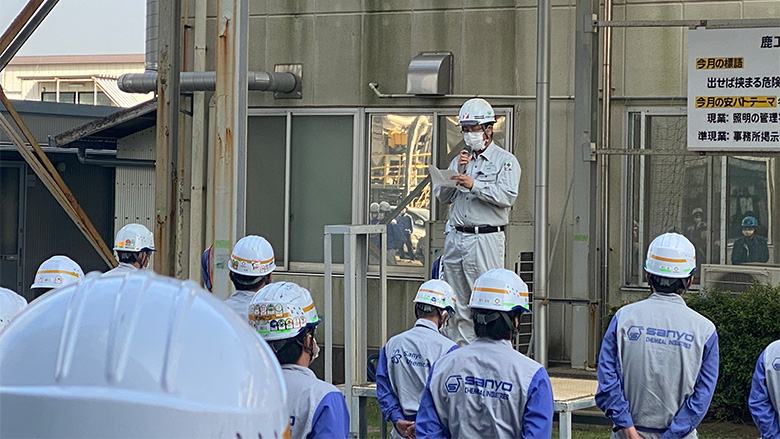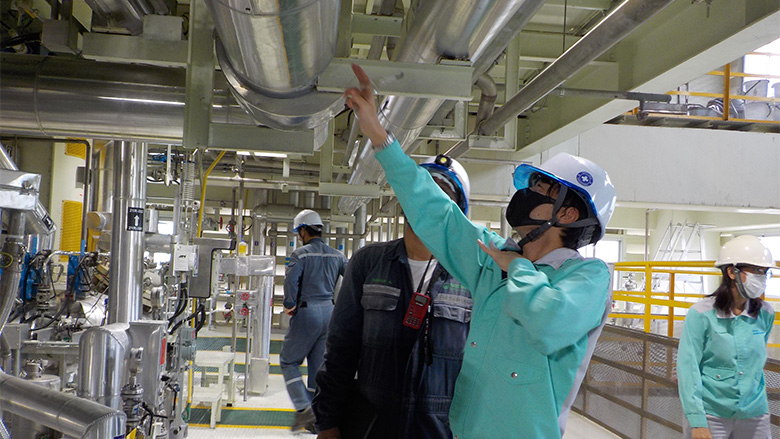Policy
We will prioritize safety and accident prevention in all business activities. We will continue to operating without accidents or injuries, contributing to the safety of society, and strive to protect the safety and health of all individuals engaged in work at our business sites, including employees and subcontractors, and to create a comfortable working environment.
Safety Philosophy and Policy
Safety Philosophy
We place the highest priority on Safety and Compliance in all our business activities.
Safety Policy
Safety comes first.
Recognizing that safety is the foundation of our business activities, and with a strong determination to ensure that no one will be injured or will injure others, we will work on the following as our basic policy.
- Observance of basic safety rules
- Execution of health and safety activities
- Improvement of crisis management capabilities
System
The Sanyo Chemical Group has established an Environment and Safety Group at each factory for occupational safety, health, and accident prevention at each of its production bases. The Environment and Safety Dept.’s Safety Promotion Group directs and supervises all production bases, including research laboratories, the Head Office, branch offices, and sales and marketing offices.
In case of an emergency, a local emergency task force will be established in the region where the emergency has occurred. Should other wide-area disaster such as a large-scale earthquake occur, the Business Continuity (BC) Task Force will be set up at the Head Office to implement support and reconstruction activities on a company-wide level under the control of the General Manager of the Environment and Safety Headquarters designated by the President.
System Diagram

Internal Audit on Environment, Safety, and Accident Prevention
The Responsible Care Dept. and the Safety Promotion Group of the Environment and Safety Dept. visit each facility once a year to conduct audits on environment, safety, and accident prevention by targeting factories and research laboratories.
In FY2024, we conducted audits on the status of accident-related information sharing and efforts to implement the autonomous management of chemical substances in response to amendments to laws and regulations related to the Industrial Safety and Health Act.
We are also conducting environmental management audits to replace the ISO14001 certification that was returned at our domestic factories.
Status of Labor Accidents
In order to achieve zero labor accidents, our Group is conducting activities under the main themes of risk assessment, creation of a workplace culture in which workers warn each other, thorough implementation of recurrence prevention measures, and achievement of a safer work environment.
There were no serious accidents in FY2024. In addition to one occupational accident involving our employees with lost time and four non-lost time accidents, there was one lost time and three non-lost time accidents among temporary staff and subcontractor employees.
We investigated the causes of each accident and implemented measures to prevent recurrence, replicating them at Group companies both in Japan and overseas.
Occupational accident frequency rate*1

*1 Frequency rate = (number of victims suffering accident with lost time) ÷ (total working hours) × 1,000,000
This value indicates the generation frequency of accident victims per 1 million working hours.
Occupational accident severity rate *2

*2 Severity rate = (labor lost days) ÷ (total working hours) × 1,000
This value indicates the severity of accidents per 1,000 working hours.
Safety and Technology Education Center
In 2012, we opened the Safety and Technology Education Center at the Nagoya Factory with the aim of improving safety education and production technology.
At this facility, participants can learn principles and theories by using devices that allow them to experience the danger of labor accidents and that simulate production site equipment. We are also working to improve our educational materials by creating videos of past accidents and disasters that have occurred at our company, as well as introducing a VR program.
We also provide safety training for subcontractor employees in this facility.
Safety / Technology Education
(unit: people)
*Horizontally scrollable
| FY2020 | FY2021 | FY2022 | FY2023 | FY2024 | ||
|---|---|---|---|---|---|---|
| Participants (people) | Employees (including transfers) | 93 | 168 | 96 | 169 | 153 |
| Subcontractor employees | 12 | 35 | 20 | 141 | 44 | |
| Visitors and guests (people) | 19 | 55 | 47 | 109 | 206 | |
| Education time (total hours) | - | - | - | - | 3,454 | |
Risk Assessment
Our Group systematically conducts risk assessments of target chemical substances handled at our factories and research laboratories and takes necessary risk mitigation measures.
While we have traditionally focused on equipment-related measures and established rules, we have also been working to resolve issues in the Production Division with the participation of outside experts since FY2024. To strengthen risk assessment and ultimately improve safety at production sites, we are making a long-term effort to develop human resources who can appropriately identify risks and propose mitigation measures.
In FY2024, we conducted training for production site managers with the aim of improving their process risk assessment skills. We will expand the target participants for this training as part of efforts to continue providing risk assessment training.
Safety and Accident Prevention Activities
For safe operations and business continuity, we have implemented measures on both the hardware and software perspectives, and have also established response and action plans in the event of any unusual situations, which we regularly practice through training.
Unusual Situation Handling Training and Emergency Response
In accordance with the annual schedule, we repeatedly conduct training in cooperation with the local communities, such as training for unusual situation handling in the unlikely event of an earthquake, fire, leakage, or other contingencies, and joint training with neighboring factories and local fire brigades. In particular, in recent disaster prevention drills, we are conducting training without using scenarios to enhance practical response capabilities. To prevent the past serious occupational accidents from being forgotten, the “Company-wide Safety Day” was established (held every October), where various events related to safety such as emergency training, evacuation training, emergency contact training, safety patrols, and safety talks are conducted in each regions both in Japan and overseas.

Kinuura Factory: Joint drills with Handa Fire Department
(AED training)

San Chemical Co., Ltd.:Safety patrols

Sanyo Kasei (Thailand) Ltd.: Review of the accident
Earthquake Countermeasures
Following the Great Hanshin-Awaji Earthquake in 1995, we have continued to implement seismic reinforcement of buildings and production facilities. In addition, since 2007, we have been working on the formulation of a business continuity plan (BCP) and training. Kashima Factory was damaged in the 2011 Great East Japan Earthquake, but it was able to quickly resume operations as a result of BCP training. Based on this disaster experience, we are continuously conducting reviews of BCP training and response manuals.
Predictive Maintenance and Accident Prevention Measures
We have started predictive maintenance using artificial intelligence (AI) and digital transformation (DX) to measure and monitor the condition of equipment and replace or repair parts at the appropriate timing. We believe that this approach can help to reduce unnecessary part replacements and unexpected issues compared to the method of performing regular maintenance.
Furthermore, a system has been introduced where skilled workers can view and give instructions based on the footage from smart glasses worn by on-site workers from outside factories.
In addition, initiatives at each factory are shared through web communication tools and company-wide announcements at Safety Session to help strengthen accident prevention measures.